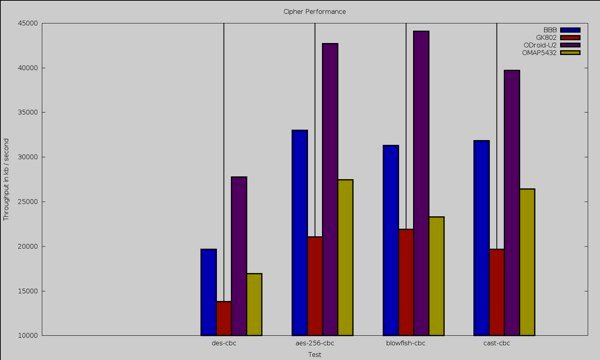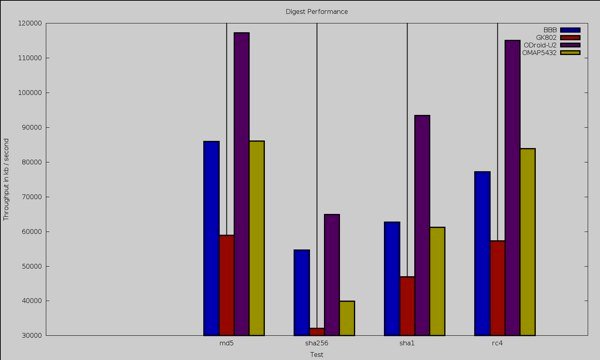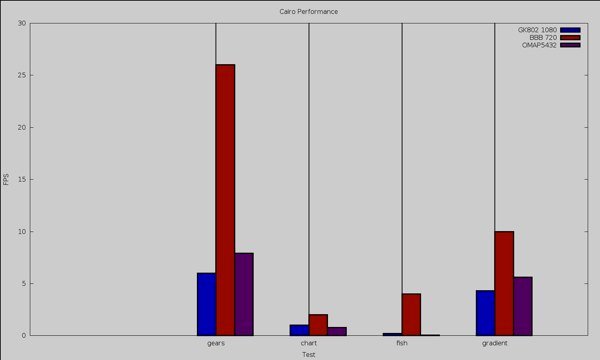Texas instruments and SVTronics announced an OMAP5 evaluation board a couple of months ago. The board features OMAP5432 dual Cortex A15, dual Cortex M4 SoC, 2GB RAM, a 4GB eMMC module, USB 3.0, SATA and more. SVTronics sent a board to Linux.com, where they wrote a short review, followed by an article benchmarking the OMAP5 EVM against AllWinner A10, Freescale i.MX6, Exynos 4412 Prime, and TI Sitara platforms, namely Cubieboard, GK802, ODROID-U2, and BeagleBone Black, all running Linux. Ben Martin, the writer, also benchmarked the board against a Linux PC powered by an Intel Core i7-2600K processor (4 cores, 8 thread, clocked at 3.4GHz, with a turbo frequency up to 3.8GHz).
The board used was an early version, clocked at 800MHz, and later in September, all boards will be clocked at 1.5Ghz, so for benchmarks that stress the CPU, you could expect almost double the performance. With that in mind, let’s have a look at the benchmarks and results.
Octane Benchmark
The Octane Benchmark measures a JavaScript engine’s performance, and it able to leverage multi-core configurations. Here are the results from lower to higher overall scores:
- ODROID-U2 – 1411
- OMAP5432 EVM – 1914
- Intel Core i7-2600K – 9667
Cubieboard and GK802 overall scores were not provided but you can see the different Octane test results for all 4 ARM targets in the chart below.
Despite having just 2 Cortex A15 cores @ 800 MHz, OMAP 5 EVM matches and in many cases, outperforms ODROID-XU with its 4 Cortex A9 Cores @ 1.7GHz. Mandreel tests are particularly interestingly, as OMAP5 appears to be much faster. This tests relies on WelGL so the GPU performance should also be taken into account, but probably does not explain the massive difference between OMAP5 and others.
Unsurprisingly, the Intel processor is way ahead with a score about 5 times greater. Once OMAP5 is clocked at 1.5GHz, the difference should only be 3x, which is actually less than I would have expected.
OpenSSL Benchmarks
The first test was to build OpenSSL natively. It took over 7 minutes on OMAP5432 EVM, over 8 minutes on GK802 mini PC, and about 1 minute and 30 seconds on an Intel 2600K CPU.
OpenSSL benchmark were then run on several hardware platforms for Ciphers (DES, AES, Blowfish, and Cast)
and Digests (MD5, SHA256, SHA1, and RC4).
ODROID-U2 is the fastest device in this particular test. The oddity is the BeagleBone Black (BBB) which can outperform the quad core i.MX6 in all tests, and Exynos 5 in some, with its Cortex A8 processor @ 1GHz. According to Ben, OpenSSL tests only use a single core. This can be part of the explanation, but I can also see Sitara AM355x processors support AES, SHA, and MD5 hardware acceleration, and it may have been implemented in openSSL.
2D Graphics Benchmarks with Cairo
Cairo Performance Demos version 1.0.1 were used to test 2D performance, and based on the test results OMAP5 has not been optimized just yet for this type of task, as the Beaglebone Black vastly outperform the OMAP5432 EVM. For some reasons, GK802 is not doing well either. We don’t know which Linux image was used for the test, and it could an GK802 image without 2D acceleration.
Storage Benchmarks (Flash and SATA)
Ben ran Bonnie++ to test both flash and SATA performance. Since the system has 2GB RAM and 4GB internal flash, caching strongly skewed the internal Flash read speed:
- Sequential output – 11.5MB/sec
- Sequential read – 496MB/sec
- 3270 seeks/sec.
Command line used:
|
1 |
bonnie++ -f -m omap5432flash -s 1000 -r 500 -n 0 -d `pwd` |
SATA benchmark performed with a 120GB Sandisk Extreme SSD with an EXT-4 partition are probably more interesting:
- Write speed – ~66MB/sec
- Read speed – ~131MB/sec
- 8558 seeks/sec
Command line:
|
1 |
bonnie++ -f -m omapsandisk120 -d `pwd` |
For reference, Hardkernel did a similar benchmark with ODROID-XU (Exynos 5410, 4x Quad A15, 4x Quad A7) but via a USB3 to SATA 3 adapter, and an OCZ’s Vertex3 128GB SSD. Instead of Bonnie++, they used dd with nocache flag, and found a write speed of 190 MB/S and a read speed of 150MB/s. Difference interface, different test method, and different SSD drive, so we should not compare these results directly, yet this still gives an idea of SSD performance on powerful ARM boards.

Jean-Luc started CNX Software in 2010 as a part-time endeavor, before quitting his job as a software engineering manager, and starting to write daily news, and reviews full time later in 2011.
Support CNX Software! Donate via cryptocurrencies, become a Patron on Patreon, or purchase goods on Amazon or Aliexpress








